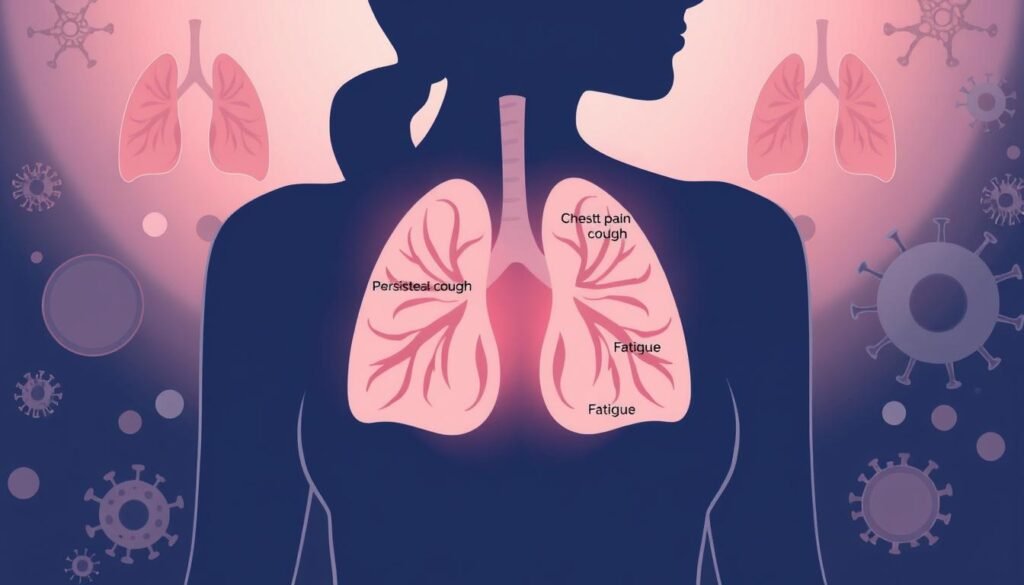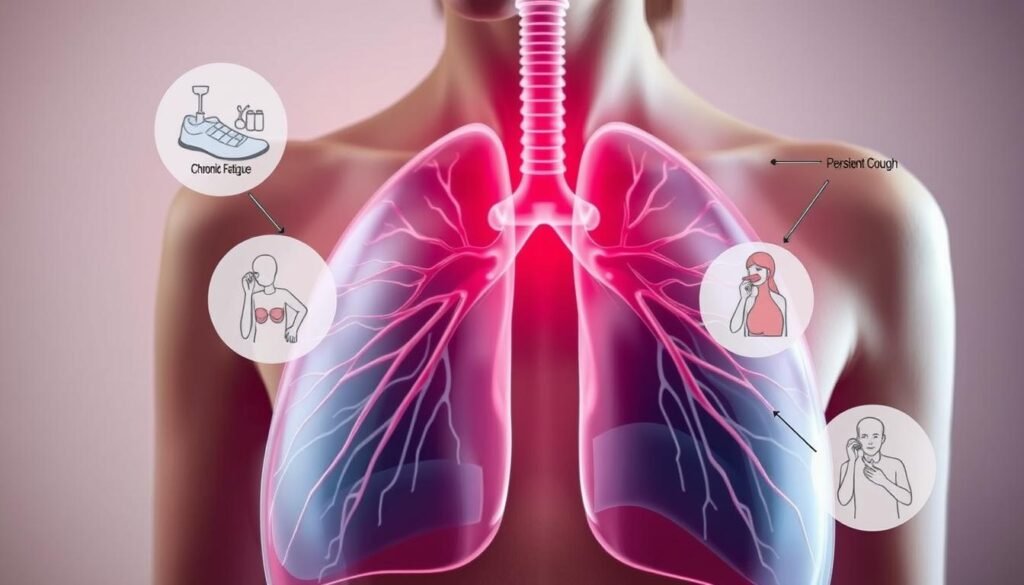Lung cancer is the top cause of cancer deaths for both men and women in the US. It’s vital to know the early signs. Often, women ignore these signs, thinking they are minor health issues. This leads to late diagnosis. Early symptoms like a lasting cough or sudden weight loss are key. Knowing these can help catch the disease early and greatly improve survival chances.
It’s important to recognize early lung cancer signs, particularly for high-risk women. Getting regular check-ups and staying alert can change the outcome. For more info on lung cancer symptoms, keep reading. This knowledge is crucial for managing your health.
Key Takeaways
- Lung cancer significantly impacts women’s cancer death rates.
- Knowing early signs leads to quicker doctor visits.
- Watch for symptoms like constant coughing and weight loss.
- Women at risk should get regular screenings for early detection.
- Better awareness means improved survival rates and health.
Understanding Lung Cancer
Lung cancer starts when abnormal cells grow in the lungs. This growth can lead to tumors. It’s the second most common cancer. Understanding lung cancer detection in women is vital. Women have higher rates of lung cancer not caused by smoking than men. This highlights the need for more research and awareness.
About 85% of lung cancer cases come from long-term smoking. While fewer men are dying from lung cancer, deaths in women surged by 84%. Women now make up over half of new lung cancer cases in the U.S. This shows a big need for targeted detection strategies for lung cancer diagnosis in women.
There are mainly two types of lung cancer: SCLC and NSCLC. NSCLC makes up about 85% of cases. Women, especially nonsmokers, often get a type called adenocarcinoma. Spotting lung cancer in women might mean looking for signs linked to adenocarcinoma.
Women have better chances of surviving lung cancer. They are 14% less likely to die from it than men. They also react better to chemotherapy. It’s important to know risk factors like family history, work exposure to cancer-causing substances, and poor air quality at home. Knowing these factors helps catch lung cancer early in women, ensuring timely treatment.
Importance of Early Detection
Spotting the lung cancer warning signs women should know about is key to treatment success. Early detection is vital to improving survival rates. Often, lung cancer starts with subtle symptoms, so being aware is important.
Seeking medical advice as soon as you notice symptoms can make a huge difference. It allows for early intervention. This can greatly change outcomes for the better.
Shockingly, very few who could benefit from lung cancer screening actually go for it. People aged 50 to 80 who have smoked a lot are advised to get screened. Low-dose CT scans can spot cancer early. This method can cut lung cancer deaths by up to 25% compared to regular chest X-rays.
In areas with high lung cancer rates, over 36% of people travel far for screening. A big gap exists in screening rates. While 80% of women get screened for breast cancer, only half of those who could get colorectal cancer screenings actually do.
Women and Black people have a higher lung cancer risk. Early detection via low-dose CT scans helps catch it early. This improves treatment chances. Paying attention to lung cancer red flags women is crucial. Acting on these warnings can save lives.

| Screening Comparison | Percentage of Eligible Individuals Screened |
|---|---|
| Annual Mammograms (Breast Cancer) | 80% |
| Colorectal Cancer Screenings | 50% |
| Lung Cancer Screenings (Low-Dose CT) | Less than 15% |
Talking with doctors about screening is smart. They can explain the pros and cons. For more info on lung cancer detection, visit this detailed resource.
Common Signs of Lung Cancer
Spotting lung cancer early can make a big difference in treatment. It’s very important for women to know these signs. The first sign is often a cough that doesn’t go away or gets worse. You might also feel pain in your chest when you breathe deeply, cough, or laugh. Having trouble breathing can be another sign, because tumors may block the airways. These symptoms can also happen with other illnesses, so seeing a doctor is crucial if they come up.
Coughing That Persists or Worsens
If you have a cough that lasts more than eight weeks, take it seriously. It could point to lung cancer or other health problems. People with lung cancer often report a persistent cough. If you’re coughing a lot, it’s a good idea to get checked by a doctor. They might suggest an in-depth examination to find out more.
Chest Pain and Discomfort
Chest pain can be a symptom of lung cancer. It might happen because a tumor is pressing on healthy lung tissue or nerves. This pain gets worse when you breathe deeply, cough, or laugh. If you’re experiencing unexplained chest pain, it’s a key sign of lung cancer. You should definitely talk to a healthcare provider for a check-up.
Shortness of Breath
Feeling like you can’t get enough air is a common symptom of lung cancer. Tumors growing in your airways can make breathing hard. Since many women with lung cancer experience this, it’s important to see a doctor. Especially if you have this problem along with other worrisome symptoms.

| Symptom | Description |
|---|---|
| Coughing | Chronic cough lasting over eight weeks. |
| Chest Pain | Pain during deep breaths, coughing, or laughing. |
| Shortness of Breath | A feeling of tightness or difficulty in breathing. |
Signs of Lung Cancer in Women
Lung cancer in women can show many signs that are key to notice early. Some symptoms might not seem serious at first. Knowing these signs can help women get help quickly.
Coughing Up Blood or Rust-Colored Sputum
Coughing up blood or seeing rust-colored sputum is a big warning sign. It might mean something serious is going on. Women should take this sign seriously and see a doctor fast for a better chance at recovery.
Unexpected Weight Loss
Unexplained weight loss is a worrying sign of possible lung cancer. If you’re losing weight without trying, it could be bad. It’s a call to action to check with a doctor, as it may link to lung cancer.
| Symptom | Significance | Statistics |
|---|---|---|
| Coughing Up Blood | Critical sign of possible lung cancer | Affects about 21% of women with lung cancer |
| Unexpected Weight Loss | Possible indicator of serious health concerns | Common symptom observed in various cancers |
Less Common Symptoms to Watch For
When talking about lung cancer in women, some signs are not well known. These signs can help spot lung cancer early in women. It’s very important to know these signs for fast action and treatment.
Hoarseness
Hoarseness happens when tumors affect the vocal cords, changing the voice. This can start slowly and might not be noticed right away. Women with long-lasting hoarseness should pay close attention. This is especially true if they have other symptoms of lung issues. Talking to a doctor quickly is important to check if it’s lung cancer.
Chronic Fatigue
Chronic fatigue can point to a serious illness like lung cancer. Feeling tired all the time, even without working hard, is a big warning sign. For women, it’s important to see this sign along with other symptoms of lung cancer. The body might feel drained, needing proper nutrition and care. Talking about ongoing tiredness with a doctor can help find lung cancer early in women.

Signs of Lung Cancer That Indicate Metastasis
Metastatic lung cancer is when cancer cells move from the lungs to other body areas. This advanced stage shows many symptoms, indicating how far the cancer has spread. It’s important for women to know these signs early. This can help them get medical help sooner.
Women need to watch out for signs that show lung cancer may be spreading.
Bone Pain
Bone pain is a big worry if lung cancer reaches the bones. Patients often feel pain in the back and hips. Around 35–40% of those with advanced lung cancer will have bone metastases.
Persistent or unexplained bone pain is a clue. It might mean lung cancer in women.
Neurological Changes
When lung cancer reaches the brain, neurological changes can happen. These include headaches, numbness, or issues with balance. Spotting these signs is key. They are critical lung cancer warnings that women should not overlook.
Knowing about these brain-related changes can lead to fast action. This can greatly improve treatment results.
Recognizing Lung Cancer Red Flags in Women
Spotting early signs of lung cancer in women is crucial. Quick notice can lead to timely help. Some symptoms are key signs of lung cancer that women need to watch for.
Frequent Respiratory Infections
Women with many respiratory infections, like pneumonia or bronchitis, should be alert. These may hint at lung issues, possibly from tumors. It’s crucial to recognize these signs for early detection of lung cancer.
Wheezing and New Breathing Problems
Starting to wheeze or facing new breathing troubles are major alerts. These problems are serious and shouldn’t be ignored. They could signal lung conditions. Keeping track helps women talk to their doctors, starting the search for lung cancer signs.
Consulting Your Doctor: When to Seek Help
For women, if you notice symptoms like persistent coughing, unusual fatigue, or other signs, see a doctor quickly. It’s really important to catch lung cancer early. It can change your treatment options and results. Don’t wait to talk about your concerns, especially if lung cancer runs in your family or you have other risk factors.
Talking clearly about your symptoms with your doctor can help a lot. It leads to a better understanding and the right tests. You should ask about your type of lung cancer, what stage it’s in, and treatment choices. Being active in your care reduces worry. It makes sure you get the support and info you need during your cancer journey.
The American Cancer Society has a 24/7 helpline at 1-800-227-2345 for lung cancer help. Getting in touch with healthcare pros can connect you to patient programs and resources. It’s key to speak up and see your doctor early. Doing so can really help in fighting lung cancer.